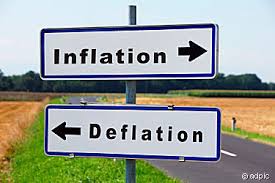The last couple of months have seen a steep fall in inflation rates. The WPI, acronym for Wholesale Price Index, which depends on the inflation rate, fell from -2.4% in June to -4.05% in July. This was mainly driven by a fall in food prices by 1.16% and a fall of 1.47% in prices of manufactured goods. Inflation in retail also fell from 5.4% in June to 3.78% in July.
Inflation can be defined as a prolonged increase in general price levels. It leads to a hike in prices of goods and services. Inflation usually occurs over a period of time. As price increases, the quantity of goods and services a consumer can buy falls. Therefore, a rise in prices leads to a reduction in a consumer’s purchasing power, that is, his/her real money balances falls (W/P). The most common form of measuring inflation rate is Price Index.
Inflation has both positive and negative impacts. The negative impacts of inflation are hoarding of commodities due to high prices, increased cost of holding money, fall in savings and investment due to uncertainty in inflation rates in the future. However, the positive side of inflation contradicts the negative impact of fall in investment. A rise in inflation encourages people to spend and invest as the money they currently hold becomes less and less in value due to rapidly increasing inflation. It also causes a fall in the burden of debt, maintains a low nominal interest rate and reduces unemployment.
The opposite of inflation is called deflation. The phenomenon of deflation can be defined as a fall in general price level over a period of time. It is also called negative inflation rate. Deflation occurs when the inflation rate falls below 0%. As deflation occurs people are able to buy more quantity of goods and services with the same amount of money as they had before. Thus, the value of a consumer’s money holdings increase, that is, value of real money balances increase.
Therefore, we see that deflation is essentially a subset of inflation or an extension of the concept of inflation.





23 Comments. Leave new
Very apt, crisp and to-the-point info. Keep it up!
to the point post !
Good Work 😀
Short and to the point
Good Article
Well written
very precisely written
Very well differentiated.
Differences well brought out!
nice1
nice 😀
Factual amd well explained!
Short and precise
Well explained.
Nice article…..really liked it!
Well written.
Good effort!
Great…!!
liked the content.
Well explained!
Inflation is better than deflation for our economy.
Printing of currency leads to inflation because of surplus currency.
To control inflation government increase taxes as it leads to fall in disposable income which reduces the demand.
Therefore supply being constant , fall in demand leads to fall in general price level.
Good articulation!
Well done!
Both are two opposite unhealthy extremes inclination towards either of them retards nation and society alike very well written great efforts